
Today (Saturday April 27th), I'll be selling some vintage clothing at this market, at The Model Sligo, from 12-5pm. Follow the #sligoflea tag on instagram for loads of pictures throughout the day. You can find me on instagram as illbeyourmirror


A couple of weeks ago, Maeve and myself made good on our pact to visit Glasnevin Cemetery. I bought a Groupon coupon for discounted entry a few months ago, which I thought was a good way for Glasnevin Museum to generate visitor footfall. They're selling Groupon tickets at the moment too. The skies remained a clear, deep blue for the duration of our visit, we were blessed with the weather!


Maud Gonne MacBride and Jim Larkin's graves
On April 24th, 1916 the Easter Rising began in Dublin city, and lasted for 6 days, fiercely fought by the Irish Republicans who wanted to emancipate Ireland from British rule. In the end there were casualties on both sides, and Ireland wouldn't achieve its independence until 1922. Some of the most famous figures of the Rising, assassinated for their part in the Rebellion, are buried here at Glasnevin cemetery.
Glasnevin Cemetery is Ireland's largest non-denominational cemetery, established in 1832 by Daniel O'Connell "The Emancipator". The Penal Laws operating in Ireland at the time prevented Catholics from practising their religious rites publicly. Many Catholics could not afford to bury their dead in consecrated ground. O'Connell sought to redress this state of affairs. Now over 1.5 million of over 12 different faiths are buried here, death being the great equalizer.
Our tour lasted a little over an hour, they have two public tours every day at 11.30am and 2.30pm, and on different days you are treated to a historical renactment of a particular event at the cemetery. When we were there, we were presented with a renactment of Padraig Pearse’s graveside oratory at the funeral of the Fenian O'Donovan Rossa, in 1915. It was a bit naff, but its probably a good crowd pleaser, and does set the context, particularly if your memory is a little rusty on twentieth-century Irish history. It did put us in the mood for the rest of the tour. Our guide was Niall and he had a special association with the Rising, through his grandfather, who had gotten involved as a volunteer at the age of 15.

Roger Casement was one of the first graves we stopped off at. Casement was an Irish nationalist, anti-imperialist and abolitionist. He was stripped of his knighthood, and executed for treason on August 3rd, 1916, for his involvement in the Easter Rising, this judgment is said to be strictly enforced due to the recent discovery of Casement's "black books" which revealed his homosexual activities.
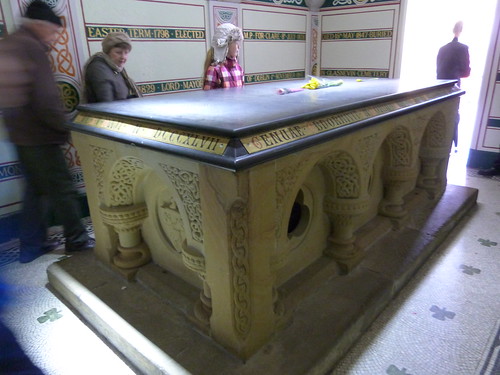
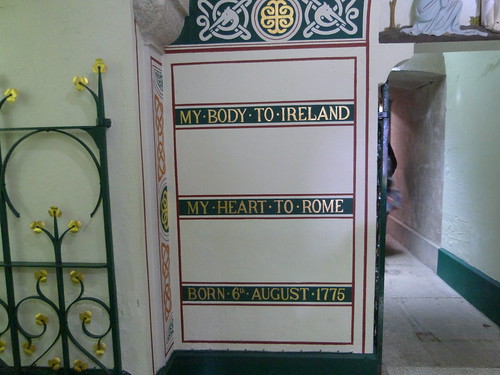
We were taken into the O’Connell family crypt underneath the round tower. Visitors were once able to climb the tower, until an Loyalist bomb was planted there in the late 1970s, which destroyed the staircase. The Glasnevin Trust is a registered charity, so they rely heavily on visitor income and fundraising. They hope to reinstate the staircase inside the tower at some point in the future. The crypt was recently refurbished, in 2009. The quotations on the wall are said to be O'Connell's dying words; "My body to Ireland, My heart to Rome", which was taken literally, as his heart was taken to what was then the chapel of the Irish College there, now the Sant'Agata dei Goti.
O’Connell’s coffin takes centre stage once inside the crypt. The macarbe part of me got a thrill at seeing O’Connell’s coffin, which is visible through the marble tableau above it. The interior has undergone a recent restoration with bright murals painting on the walls, outlining key dates in O’Connell’s life.

Afterward we went to where Charles Stewart Parnell is buried, above the cholera pit. Popular legend speaks of how one of his dying requests was to "bury me with my people", which was honoured, whether this is true or not.
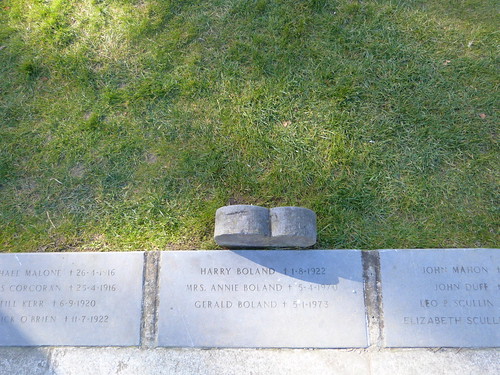
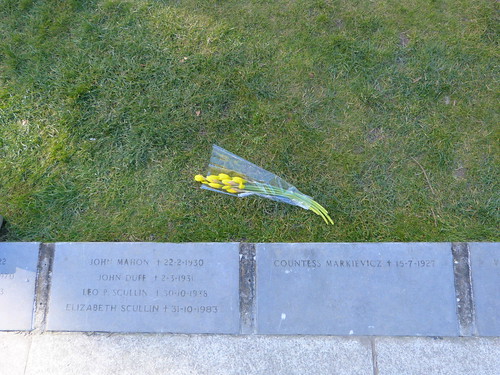
On the final leg of our tour we were brought to the Republican plot, where the names are so familiar to all of us who’ve come through the Irish primary school system. The plot is simple and unadorned, the grave markers recording only their name, and the dates of birth and death. A young boy was very enthusiastic about this part of the tour, I could empathise, having had an appetite for Irish history when I was in school myself (and retain to this day may I add!). I would love to see more little girls express the same interest, perhaps if the Women of 1916 were celebrated more (watch this space!).
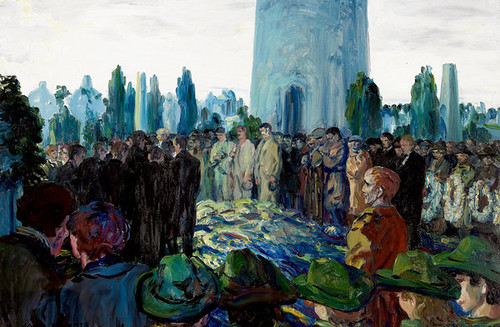
The Funeral of Harry Boland (1922) by Jack B. Yeats.
Harry Boland, an Irish nationalist, was a member of the First Dáil. Boland joined the Irish Volunteers and took an active part in the Easter Rising of 1916. Boland was Michael Collins best friend and right hand man, but their friendship was strained as Boland opposed the Anglo-Irish Treaty. In November of 1922, Boland was accosted by soldiers of the Irish Free State Army at a hotel in Skerries, and though he was unarmed, he was mortally wounded and later died from his injuries. At his burial in Glasnevin, no press nor photography was permitted, and thus Yeats' painting is the only pictorial evidence of this event. This painting is held in the Niland Collection at The Model, Sligo. I had the pleasure of speaking on this work during some summer tours of the gallery I gave last year. You can see the base of the O'Connell monument (as in my first photo) in the picture.

Michael Collins grave is the most visited grave in Glasnevin, unsurprisingly as it is set apart from the others, close to the Glasnevin Museum building. Personally I wasn't a fan of its position, I'd like to have seen Collins' grave beside his contemporaries. Set apart from the others, the sensitive side of me sorry for the grave, alone.

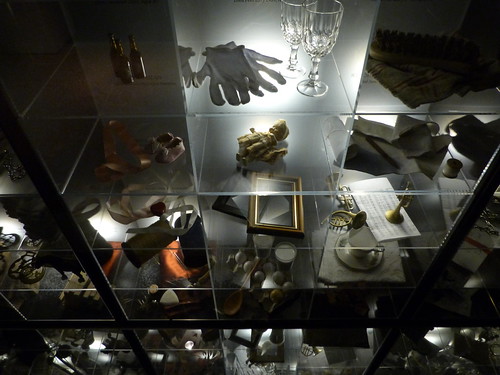
![]()
The Museum is contained in the basement, and is eerily enjoyable, it includes some quirky coffin seating in the interactive cinema and models of gravediggers, as well as some excerpts of recorded conversations between Glasnevin Gravediggers in a local pub. The mood remains dark and contemplative. There are interactive panels that explain in an intelligent but understandable manner, the philosophies of each of the religious faiths that are buried here. A series of display boxes includes the names of some of those interred there and some items associated with them during their life.

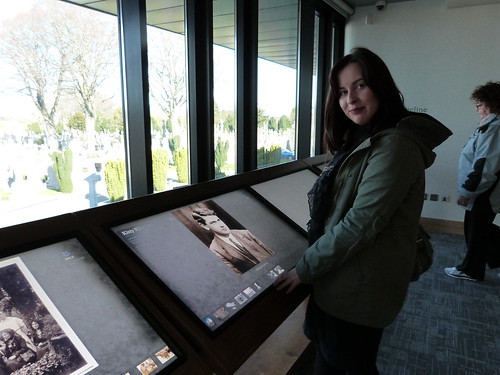


The museum continues upstairs with an interactive exhibition, and a small display of some O'Connell memorabilia. You can browse through the interactive exhibits and learn about the famous 'residents' of Glasnevin. I like that you have a view of the graveyard in front of you as you do this, a reminder of past, present, and future.
Glasnevin Museum have a strong social media presence and you can intereact with them on twitter, facebook and instagram.
Getting to the cemetery from the city centre is very simple, you can get Dublin bus 140 from O'Connell Street, a bus ticket is around €2.20.

Last weekend, with Denise as my host, we took a spontaneous trip in her car around North Sligo. We drove down lanes and along coastlines that neither of us had explored before.


First we checked out Shell’s latest venture ‘Shells Little Shop’, a creative haven where artisan foods and locally designed jewellery are merrily arranged alongside each other in their shiny new shop space. You could almost smell the paint!
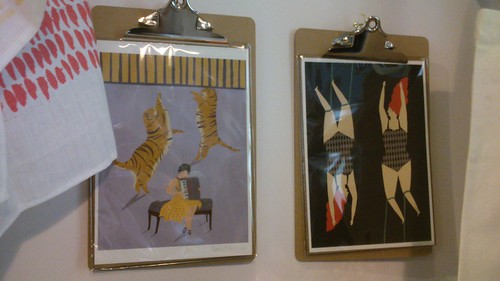

I was trying my hardest not to be tempted by any of the many lovely things they have there. One of my favourite pieces was the Salt of the Earth jewellery range, designed and created in Strandhill, a hop skip and jump out the door! I believe the designer has a background in architecture, and the interesting geometric shapes and soothing pastel tones certainly allude to that.

After poking around a bit, and many ooohs and aaaahs later, we sat down to lunch. It's such a popular spot, especially on the weekends, there is typically a small waiting list for food during the day. I had wild mushrooms and scrambled eggs on toast (the bread is baked instore, would you expect anything less?) with a drizzle of truffle oil. They always have at least two vegetarian options available. If I'm in before 2pm I always ask for the veggie breakie (it’s off the menu, but you only have to request it).



Later we found ourselves climbing over gates and pulling faces at sheep (mostly me). We explored an old ruin near Raghly harbour. There’s some really unusual houses out that way, and its an area that’s popular with artists. I’m not at all surprised, its very calm out there, with a gentle pace of life, and an uninterrupted view of the changing blue sky. We had a different perspective of Benbulben from here (see first picture).

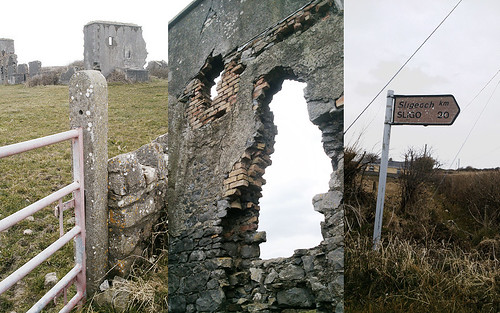
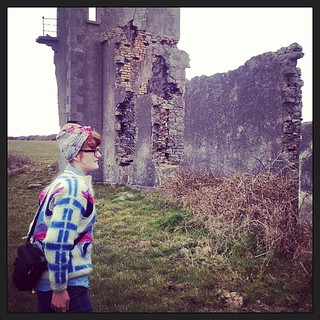
1 - Ardtarmon House (c. 1852), a beautiful country retreat and a B&B, 2 & 3 - exploring a mystery ruin near Raghly Harbour
This is just one of many potential Sligo Sundays! Fingers crossed for some more adventures soon!

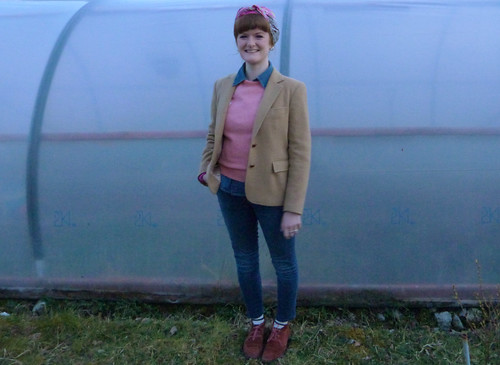
Headscarf - vintage, 1960s / Wool blazer - thrifted / Jumper - thrifted / Denim shirt - thrifted / Jeans - Topshop Pippa's / Boots - Camper
An invitation to the pub while enthusiastically accepted on my part, leaves me with a bit of dilemma for at least nine out of the twelve months of the year. Ireland is cold. The Romans never colonised Ireland, calling us 'Hibernia', or the land of eternal winter. So the pub dress code calls for layering, mostly for your journey to and from your pub of choice. The pub does attract an eclectic mix of people, some manage to wear a skimpy dress, platform heels and a light jacket and apparently feel no chill. With the risk of spillage in mind, I usually wear a pair of jeans, a favourite pair of ankle boots, and a blazer so it looks a bit smart and like I made the effort. A jumper, shirt are a must (or a blouse depending on what type of social gathering it is - like a date) thermals are optional, or leave that to the imagination!
An Irish pub is vastly different to a bar, granted, they're both crowded, but the pub rattles with the hum of conversation rather than the efforts of the in-house DJ. The floor is scattered with odd stools, some low and wooden, some covered in leather, the best one's have cosy wooden snugs. The tables often require the aid of a few beer mats under the leg, but once you've settled and removed your layers, you can then luxuriate in the warmth that embraces you as you catch up with your pals.
I thrifted this blazer last week, I don't usually wear camel so I'm a bit wary of it yet, but for Spring it does go nicely with softer, more pastel shades. This jacket has no label, only an ILGWU (International Ladies Garment Worker Union) tag. Its hard to date, but I would go with late 70s/early 80s, it has wonderful leather covered buttons. The ILGWU, begun in 1900, ceased in 1995. It's fully lined, I think the material is wool, and it is very comfortable to wear, I find most high street blazers uncomfortable and cheaply made. For comfort and laziness sake I wore this with a pair of long socks and my well-loved Camper boots. My hair is boring me at the moment, so I pinned it up and tied a scarf over it.
The scarf I got a few weeks ago in a charity shop. The St. Michael label is from the 1960s. I'm not usually gone on floral prints, particularly as the vintage inspired "ditsy" floral revival has flooded the high street, there are cheap reproduction florals in every store you wander into, and my eyes are tired of looking at them. I love the contrasting colours of this - the hot pink, orange and green, then the black stems of the flowers in the centre, occasionally broken up with small florals imitative of the border flowers.
The look itself, I suppose it has a Land Girl feel to it. Instead of working the fields however, I was having a gossip down the pub.

Close up of scarf print
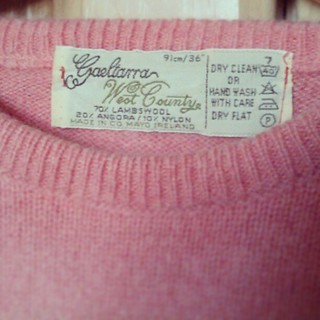
Close up of jumper label - Made in Co. Mayo!
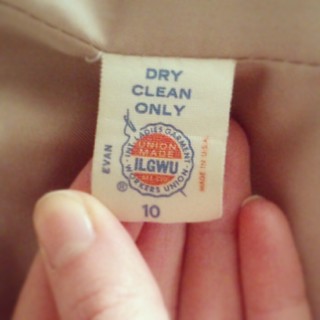
ILGWU (International Ladies Garment Worker Union) tag on blazer
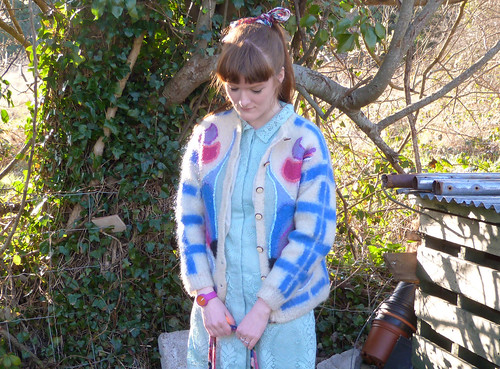
It's been a while since I've done an outfit post, I enjoy dressing myself and thrifting but am awkward in front of the camera lens for all sorts of reasons (1. asking someone to do it, 2. said person not being especially good at taking photos). This is an ultra girly outfit, and I was mistaken for being in my mid-teens while wearing it, but I like to mix things up - I could be a vamp next week, who knows.
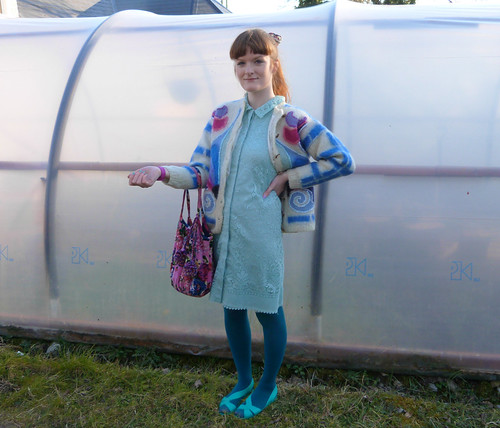
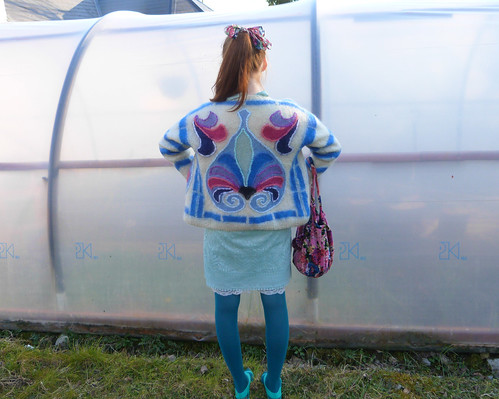
Cardigan: Thrifted, Jaeger wool/pattern label / Dress: H&M / Shoes: JuJu Jellies / Bag: Accessorize (c. 2009) / Watch: One Spot
The past couple of months I've thrifted some lovely woolens in my local charity shops. This cardigan was €4. The label reads 'Knitted from Jaeger handknitting yarn' - it needed a lot of TLC, the lining was sagging - a sure sign that the cardigan had been machine washed and shrunk. So I patiently handwashed it and gradually stretched it out, to restore it to some of its original length. I love the pattern, it reminds me of 60s prints and art nouveau designs. It's perfect for the weather we're having recently, the sun is shining but its cold and windy.
I increasingly find myself spending more time sulking in front of the mirror lamenting on how I've nothing appropriate to wear, probably because I have excess free time on my hands and have more time to think about such things. These shoes, the dress and bag are probably some of the oldest items I have in my wardrobe, the bag and shoes were bought 4 years ago, the dress 2 years ago. I need to be more discerning about what I buy, but for now I'm just having fun!
This is from a Nigella Lawson recipe, I spend too much time watching daytime tv these days (someone hire me ... soon!) and I saw this on a repeat of Nigella Kitchen on the Food Network UK.

This recipe is useful for when you pick up reduced vegetables in your supermarket, it makes for a good shared meal. I omitted some of the ingredients, as I didn't have them and they were expensive to purchase, or I just plain forgot! I used frozen cauliflower as it was cheaper, and it was just fine.
I have put into brackets what I omitted, and I just doubled the quantities of the mange tout and baby corn, according to what I had at the time.
Ingredients:
2 tablespoons olive oil
1 onion, sliced
Pinch sea salt
1 green chili seeded and finely chopped
3/4-inch chunk fresh ginger, peeled and cut into fine strips
1/4 teaspoon chili flakes
1 teaspoon turmeric
1 teaspoon ground cumin
1 teaspoon ground coriander
1 teaspoon ground ginger
1 can coconut milk
600ml vegetable stock
1 teaspoon sugar
(1 tablespoon tamarind paste)
(300g broccoli, broken into florets)
300g Cauliflower, separated into florets
125g Baby Corn, halved
150g Mange Tout (or sugar snap peas)
Method:
- Heat the oil in a large saucepan and fry the sliced onion and garlic, sprinkled with the salt flakes until it softens. Add the green chili and ginger strips and stir every now and again while cooking for about 1 minute.
- Add the chili flakes, turmeric, ground cumin, and ginger. Stir well and cook for another minute or so, before adding the coconut milk, stock, sugar and tamarind paste (if you have it). Stir to combine.
- Bring the sauce to the boil. Add the cauliflower (and broccoli) florets and cook for about 10 minutes. Then add the baby corn and cook for a further 3 minutes. Cook until vegetables are tender (about 5-10 min), then add the mange tout, and ground coriander, and cook for a further 3-5 minutes.
- Season to taste, sprinkle with the fresh coriander. Serve with rice, or naan bread.
- Should serve 4 people, generously.
I believe this freezes well, keeps for 3 days in the fridge for leftovers!
Get involved in the #meatfreemonday campaign!











































